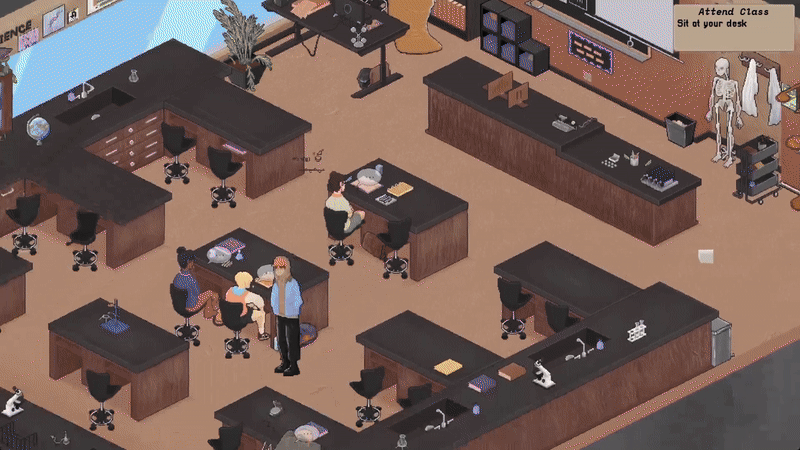In the indie scene, few games manage to capture the emotional complexity of adolescence while delivering a compelling gameplay hook. Sunset High, developed by Turnip Games, doesn’t just attempt this—it practically nails it. Blending mystery, time loops, and high school drama, this 2D narrative-driven adventure carves out a unique space between visual novel, puzzle game, and coming-of-age tale.
You Had One Text. Then Everything Changed.
The premise is deceptively simple. Your crush goes missing. You received a text from them last night. And now you’re stuck reliving the same school day over and over again. Welcome to Sunset High, where teen angst meets supernatural weirdness. What begins as a missing person case quickly spirals into a layered narrative about identity, consequence, and choice.
As the protagonist, you must navigate a maze of social dynamics, moral decisions, and branching timelines to uncover the truth. Fortunately, you’re equipped with a robust set of tools: the ability to rewind and fast-forward time.

Rewind, Fast-Forward, Regret, Repeat
The rewind mechanic is where Sunset High truly shines. It’s not just a gimmick—it’s central to how the story unfolds. Say the wrong thing to a classmate? Miss a critical clue? Just hit rewind and alter your approach. Every decision has ripple effects, and the game encourages experimentation. There’s no single “right” path, and that’s the point.
On the flip side, the fast-forward feature helps avoid repetition fatigue. Nobody wants to sit through the same exact scene five times. The developers cleverly let you jump to key decision moments, preserving narrative momentum while still respecting the time loop conceit.
Persona-Fied Choices
An intriguing twist comes in the form of the “personas” system. Rather than a static character, your protagonist evolves over time, shaped by your choices and conversations. These inner voices act like RPG classes, offering new dialogue options and clues. Leveling them up unlocks more paths through the story. It’s an innovative, layered mechanic that adds depth without overcomplicating things.
Each persona taps into a different aspect of the high school identity crisis: the detective, the rebel, the people-pleaser. It subtly raises the question: who are we, really, when everyone sees us differently?
Clique Bait
The students of Sunset High are as crucial as the time loop itself. Each represents a stereotypical high school archetype: Ambrose the Nerd, Ava the Prep, Bobby the Slacker, Bronwyn the Jock, and Dee the Punk. But these aren’t flat tropes. With enough digging (and rewinding), you’ll uncover the complexities behind their masks.
You’ll need to play them against each other, learn their secrets, and manipulate the social web to find your missing crush. Every conversation matters. Sometimes, withholding information is just as powerful as sharing it.

Visual Vibes and Audio Echoes
Graphically, Sunset High strikes a memorable chord. Its 2D pixel art is full of nostalgic warmth but layered with enough stylization to feel modern. Dreamy color palettes and moody lighting give the school halls an eerie beauty, like you’re walking through a memory.
Sound-wise, the game is a mixed bag. The music is evocative and well-timed, with each character having their own theme. But volume levels are inconsistent, and specific audio choices (especially in some teacher scenes) feel jarring. It’s nothing game-breaking, but it can pull you out of the moment.
Navigational Growing Pains
Control-wise, things aren’t always smooth. The lack of mouse support can make navigating dialogue-heavy scenes and menus clunky. Keyboard-only movement works, but it occasionally feels like a mismatch for the otherwise polished presentation.
That said, the developers seem open to community feedback. Minor gripes like UI and accessibility could easily be ironed out in future patches.
Looping Toward Something Bigger
Sunset High isn’t just about solving a mystery. It’s about navigating the complex emotional ecosystem of being a teenager. The game leans into this with authenticity. Dialogue feels real, awkward, raw, and sometimes frustrating. Characters hurt each other. They misunderstand, lash out, apologize, and grow. It’s messy, like real life.
The time-loop mechanic becomes more than just a storytelling tool. It serves as a metaphor for regret and missed chances. How often do we wish we could go back and say something different? Do something better? In Sunset High, you can. But the game subtly reminds you that some things, once learned, can’t be unlearned.

Pros:
- Deep and replayable narrative
- Time loop mechanics feel meaningful
- Strong, emotional character writing
- Gorgeous pixel art with a unique personality
Cons:
- Occasional UI and navigation clunkiness
- Inconsistent audio balancing
- Heavy text may deter some players
Sunset High: Sunset High is a bold, smart, and emotionally resonant game that takes narrative risks and mostly pulls them off. It might not be for everyone—especially those allergic to reading or narrative-heavy gameplay—but for fans of mystery, visual novels, or character-driven experiences, it's a must-play. With memorable characters, a compelling premise, and the kind of story that sticks with you, Sunset High deserves a spot on your indie must-play list. – Flare


